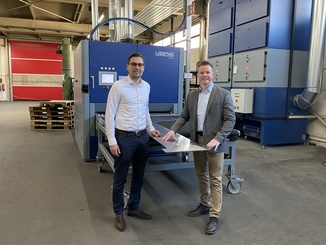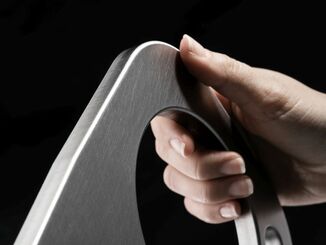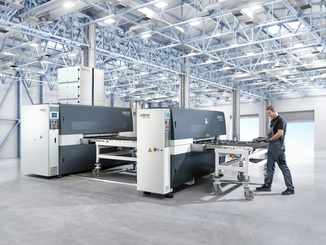
The fiber laser in particular requires downstream high-performance deburring technology due to the burrs created during cutting. A globally active company from North Rhine-Westphalia invested in these technologies several times, developing optimized production logistics and a continuous material flow at the same time.

© Lissmac/Riedinger
The production expertise that goes into the things we encounter every day is often not apparent at first glance, for example in parking or signal solutions. The Mönchengladbach-based family business Scheidt & Bachmann is one of the leading providers of system solutions for a mobile life. Among other things, Scheidt & Bachmann manufactures pay stations and terminals for parking garages or buses, signaling technology components and barrier systems, for example for Deutsche Bahn, or management systems for petrol stations and charging stations. Founded in 1872, the company has developed from a mechanical engineering company to a global system provider with around 3,500 employees worldwide. Scheidt & Bachmann has always been characterized by a high level of vertical integration – almost all metal components and parts are manufactured in-house.
Scheidt & Bachmann’s prefabrication is based in Mönchengladbach, with assembly lines in Slovakia and the USA. Scheidt & Bachmann manufactures 90 percent stainless steel parts as well as some parts made of aluminum and steel.
The sheet metal processing division in Mönchengladbach employs 90 people and produces a broad portfolio of sheet metal production items. The demands on the processing results and also on the processing technologies have risen continuously in recent years. Before 2006, laser blanks were placed on pallets after cutting, stacked and then removed individually. These were then sanded manually using simple technology. This was very time-consuming and required a great deal of manual effort and sometimes multiple passes. Throughput times, logistics and costs were also not optimal.
In 2006, the first Lissmac system was purchased for edge rounding: an SBM S 1000 for processing sheet metal and laser parts. Since then, edge rounding of inner and outer contours on both sides in just one work step has ensured significantly greater process efficiency and time savings. What was still missing at that time was structured, adapted production logistics.

© Lissmac/Riedinger
Fiber laser supplemented by powerful deburring technology
When the next step in 2019 was to modernize and invest in new system technology, several criteria were on the agenda: By purchasing a laser from Trumpf with fiber technology, the decision-makers at Scheidt & Bachmann relied on the technological advantages of the process. The purchase of the new cutting technology therefore immediately required modern and efficient deburring technology. With a view to protecting employees, ergonomic improvements were also to be achieved for the workers.
So before the new system was purchased, two system manufacturers were contacted and reference parts were sent for sample processing. The decision was finally made in favor of an SBML 1500 from Lissmac, which is used for deburring and edge rounding on both sides.
“With one sanding pass, this machine can process both sides. And it is so good that one pass is actually enough to achieve a high-quality sanding result,” says Jörg Würker, Head of Mechanical Production and Head of Sheet Metal Processing at Scheidt & Bachmann GmbH. Elaborate reworking is no longer necessary. And he mentions another important aspect: occupational safety for fitters, which then applies in the USA. “If there is a sharp-edged article in an assembly line, the fitter can injure himself – and this can quickly lead to a legal problem,” says Würker.
The fact that the technical parameters were also handed over with all the test parts was also very helpful, especially during the start-up phase with the new system. “We definitely benefited from this,” says Würker. Dirk Schürstedt, Area Sales Manager Metal Processing at Lissmac Maschinenbau GmbH, who has been supporting Scheidt & Bachmann since 2019, also remembers the initial contact and a pragmatic and constructive decision-making process. He adds: “At Lissmac, all sample processing is always documented precisely and comprehensively and made available to the customer. In other words, which machine was used for processing, which tool, which speeds, which rotational speeds and so on.” This enables the customer to achieve good machining results right from the start. Over the course of time and based on production experience, the system is usually fine-tuned to better match the processes.
For the workers, handling the new system technology was new at first, so that targeted operator training on the user interface was carried out. Overall – Jörg Würker and Dirk Schürstedt agree – the project was implemented quickly and constructively. Today, sheets with thicknesses from 0.8 to 10 mm are processed on the system. The size of the respective sheet metal blanks ranges from cell phone to table size. The system was also retrofitted with a wet extraction system in 2023 in order to be able to process aluminum and ensure material separation.

© Lissmac/Riedinger
Creation of optimized production logistics
With the purchase of the SBM L 1500 in 2019, it became clear that production logistics needed to be optimized. When two fully automated Trumpf fiber laser cutting machines with a connected Stopa storage system were purchased in 2021, the topic came up again and should now be thought through to the end. “When the employee removes the part from the laser system, he should also place it directly on the grinding machine. The continuous material flow was important to us and needed to be implemented,” explains Würker. Also to avoid manual work and long throughput times. Accordingly, two additional systems were purchased in 2022 to implement this seamless process.
“We rely on stable and functioning relationships. That’s why we opted for Lissmac technology again – this time for two systems with rotary brush technology, with which we can deburr and also round edges to an adjustable quality and depth,” says the Head of Sheet Metal Processing.
“Two universal SMD 345 S-Edition sanding and deburring machines were purchased. This time, both machines work in single-sided operation. However, they can be used to produce a defined surface finish, such as classic brush sanding. This allows for greater flexibility and cost savings in purchasing,” adds Lissmac specialist Schürstedt. With flexibility in mind, these two systems were also equipped with a wet extraction system.
Technology support is important
One thing is certain: Scheidt & Bachmann is very satisfied with the processing results of the Lissmac systems. “Since the new systems have been in use, we have reliably achieved very good deburring results,” says Jörg Würker. In addition, there is targeted technology support and reliable service.
For Dirk Schürstedt, it is important to be able to respond to the customer’s individual production conditions and requirements with precisely tailored technology. “It’s fun to be able to support the customer’s needs over the years. As machine manufacturers, we are also constantly developing the systems further. Customer feedback is important for this,” he says. At the moment, a major focus is on the operability of the systems. They should be as simple and self-explanatory as possible to make the operator’s work easier.
Author:
Annedore Bose-Munde
Web:
www.lissmac.com



